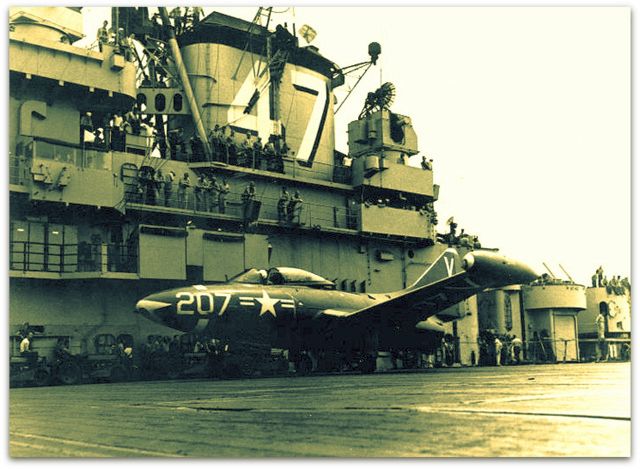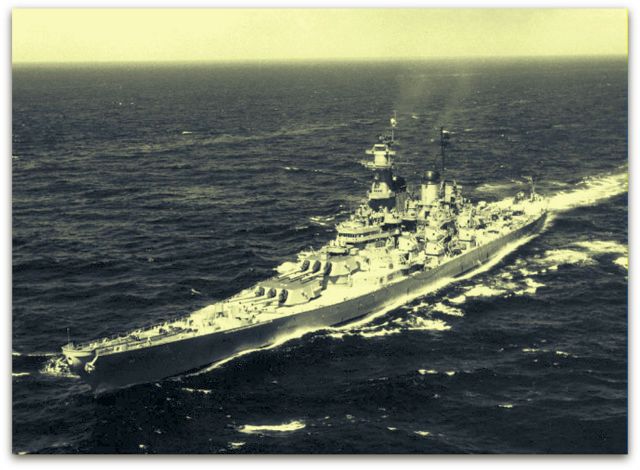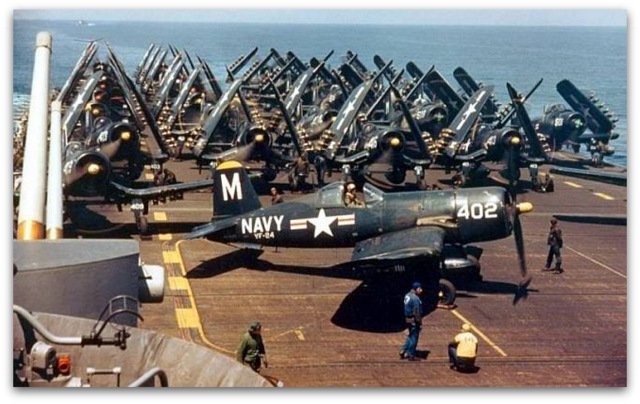

A retired Navy Commander, who in 1952 served as a Lieutenant on the USS Philippine Sea in the Operation Combat Control Center (CCI), wrote to Lawrence Fawcett, co-author of Clear Intent, with an account of UFO incidents he'd experienced during his tour of duty. (His name is on file and his Service record has been verified by Project 1947.)
Larry Fawcett was working on another book at the time of his death and the following correspondence was included in his draft manuscript.

In 1949 the promotion block to LCDR appeared to be very tight. Aviator Lieutenants were advised that if we wanted to improve our chances of promotion that we could do so by accepting a ship's company tour. I didn't want to get passed over so I put in for that type of duty. I was sent to CIC School at Glenview Ill. after which I was transferred to the aircraft carrier USS Phillipine Sea which was just then joining the task force in the Sea of Japan for operations against Korea. While on board, I qualified in all phases of CIC including AH Weather Intercept Controller and Strike Controller. Later during the tour I also qualified as an OOD underway (Day/Night Task Force/Air Operations qualified). This wasn't a superfical qualification. At one period of time there were only four of us qualified for standing watch as OOD's underway — two of us were aviators. I also set up an all weather landing system that was utilized to bring in pilots that were not able to conduct normal landings when surprised by unfavorable weather conditions on return to the ship.
Experience 2) On the evening of 2 February 1952 I had just finished watching the movie on the hangar deck and had gone up to the CIC area to
Pge 3
have a brief chat with some of the crew on watch. Our task force was located essentially in the center of the Sea of Japan about 85 miles off the coast of Korea at the time. On the large display board, a target was indicated about 90 to 100 miles from us closing rapidly in our direction. Due to the high velocity of the target I suggested to the watch officer that the board not erase the back track but keep it on the board. When it reached about 30 to 25 miles from the task force — a call came down from the bridge asking why we were not reporting an incoming target from the North — they said that the Signal Bridge had reported three objects approaching consisting of what appeared to be exhaust flames. Note > due to the high velocity of the incoming target when first observed, it was initially assumed (in CIC) that it might be a radar spook and the watch was told not to relay the info to the bridge. This call from the bridge changed everything and we immediately sent the information up to them. The objects closed over the force circling us and then moved away from us, first breaking up into two targets and both of these accelerated their velocities to about 1800 knots as they receded. Radar lost sight of them at about 90 to 100 miles. At the time I ordered the DRT (Dead Reckoning Tracer) to change their scales and maintain a track on the targets. This was done. The next morning we interrogated those on watch on the Signal Bridge and verified their visual observations of the night before.
Item 3) In the Spring of 1952 while I was still on the USS Phillipine Sea and while standing a daytime watch in CIC — an immense fog had closed down all air operations against North Korea — even the land based aircraft in South Korea had absolutely nothing flying. The fog was so thick they reported they could barely see the bow of the ship from the bridge. Obviously nothing was flying and the task force was just maintaining a slow speed position off the coast of Korea in the Sea of Japan.
Experience 3) During this watch, we picked up a very slow moving air target indicating its altitude at 7,000 feet on an incoming course from NW of North at a velocity of about 75 knots. It continued to approach us and when about 12 miles distance, our fire control gear locked on to it and started tracking. The other aircraft carrier in the force also was able to track it as well as the USS Missouri which was with us. Both the carrier and the battleship's fire control system were locked on and then two destroyers in the force also called in "Locked On". According to doctrine I requested open fire from the flag who had been watching this developing situation in Flag Plot. After a moment or two Flag Plot came back with "We request you have this request come from the Ship's Captain". Just before this verbal exchange I had contacted JOC Korea and asked them if they had any aircraft or helicopters airborne from any base. There answer was "None" They reported they were completely socked in. I relayed the above message from Flag Plot to the Captain via the MC System.

Pge 4
There was no answer although I found out later there was quite some discussion on the bridge concerning the request. When I querried (sic) the bridge for an answer — the answer came back that the Captain had decided not to make the request. No reason was given. The object came in over the force and did a clover leaf pattern around the force and proceded back off to the North at the same speed and altitude as before until fading from radar. This was a truly frustrating experience for all of us and I expect for those on the other ships of the force which were tracking and locked on. I say this because we realized that our Operational Policy Guide (which was an inch and a half thick) wasn’t necessarily to be followed in cases like this. After many months of tracking aircraft such as AD’s, F4U‘s and Gruman (sic) Jets while serving in this capacity, I came to have a fairly good recognition for the type of aircraft based on the radar return. In this case, I evaluated the target to have a very similar radar return as from that of an F4U but about 3/4 the size of the F4U’s signature return.

Item 4) The aircraft carriers on duty in the Sea of Japan during the Korean war usually stayed there for about a 10 to 11 months tour. So at the end of one of these tours, we were on our way back to the San Francisco Shipyard for a three month overhaul. We were about half way between Guam and the China Mainland when the following occured. (sic) I was on the mid watch on the bridge as the OOD at the time and we were steaming singly without escort in an Easterly Direction doing about 24 knots. The sky was clear. The seas were calm.
Experience 4) Approximately between 1 or 2 in the morning, the Surface Search Radar picked up a surface target about 4 to 5 miles ahead which appeared to be on an opposite course close to interception with us. We tracked its course and speed of about 8 knots. When it was 3 miles from us, the radar target disappeared and in its place a round-like bright light appeared. Its course then appeared to be passing us about 75 yards on our port side. All lookouts and the Signal Bridge were watching this. I deemed it not necessary to change course at the last minute and the glowing ball came down the port side of the ship, rose vertically just above the flight deck level and even with the bridge and passed just in front of the bridge crossing over to the starboard side, dropping down to a few feet above the water and continued down the starboard side of the ship going in the opposite direction to our course. The bright light ball was estimated to be about 12 to 15 feet in diameter. I quizzed the Bridge Personnel and the Signal Bridge and Lookouts to make sure they saw the same thing we on the Bridge did. They did. I held a conference on the Bridge in which we decided it might not be all in our best interests to log this incident in the Ship’s Official Log. Some did not want the prospect of interviews to bug them and the prospect of the word spreading through the ship’s company could produce ridicule and derision. I did not log it — much to my later
Pge 5
regret. Post analysis was very perplexing because here was an object that appeared to have the capability to change its mass into pure energy — to go from a radar identified target to a ball of light energy with the radar signal disappearing at the same time. The second consideration was that it exhibited knowledge that it was being tracked by radar by some object ahead of it and changed its physical format. The third consideration was that it exhibited intelligence enough to jump over the ship in what appeared a controlled maneuver and continue on its mission. Possibly a fourth consideratioin (sic) was that — what was it doing slowly moving just above the surface of the ocean on a very steady course — was it surveying the ocean floor or possibly the sea life that was in the ocean or both.
Item 5) When on station in hostile waters, the task force kept a combat air patrol, usually consisting of 4 planes, airborne at all times during operations. They were usually positioned at altitude (30,000 to 40,000 feet) not too far from the force but orbited in a position between the force and in the direction from which one might expect an intruder or an enemy aircraft coming from. Since this is a boring period for CAP (combat air patrol) pilots, the ship's air controller will sometimes run intercepts with incoming and returning friendly aircraft from the Strike Group. It gives both the air controller and the pilots practice in the interception game.
Experience 5) While I was on day watch doing my turn as CAP air controller, I and the rest of the watch detected an object at an altitude of 35,000 feet remaining stationary about 55 miles from the force. The fact it was stationary at that altitude piqued my curiosity and I vectored the CAP to an intercept. When the Cap closed to within about 20 miles of the object, it suddenly displaced itself (immediately) to a distance of 40 miles from the CAP.. Revectoring of the CAP to intercept to the new position caused the target to repeat. This continued for several intercept attempts - the target sometimes jumping (instantaneously closer and sometimes farther away from the task force, but would always jump when the CAP reached about 20 nautical miles from the target and it would put a 40 mile distance between itself and the CAP when they closed to the 20 mile range. This situation continued for 2 weeks. The CAP pilots finally objected and believed we were jerking them around in an exercise for which there was no reason. In fact, after one session, the CAP flight leader came to me in CIC and said his pilots had enough of these goose chases and wanted us to stop exercising the patrol in this manner. So we did quit but continued to observe. In the meantime, the aircontrollers of the USS Valley Forge (another aircraft carrier in our task force) got us on the VHF Chat circuit one night and told us they were experiencing the same problem and did we have any idea what this strange ultra;high maneuverable target was. This particular target only appearred on our scopes during periods that the CAP was airborne We could give them no
Pge 6
explanation. After a two week period the target disappeared. Post analysis indicates the following: There was a radar reflective target that was able determine the closeness of our intercepting aircraft and could instantaneously reposition itself when the interceptors closed to within an average of 20 miles, it was as if the intelligent target knew that this 20 mile distance was just beyond the limit of our CAP to Tally Ho. In regards to the instantaneous distance jump on an average of twenty miles, I refer you back to Experience No 4. Was this a case of the intelligent object being able to transform itself into pure energy and seemingly exceed the speed of light during the distance transform? Since the target reappeared after the distance jump, it was considered possible that it could also change its energy format back to a mass since it again reappeared as a radar target. I can give you the name of one of my cohorts who experienced the same situation as I did and also talked to the Valley Forge Air Controllers if that is necessary.
|
|
|
|
|